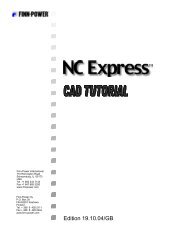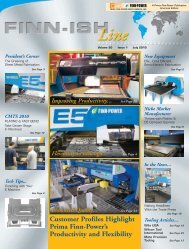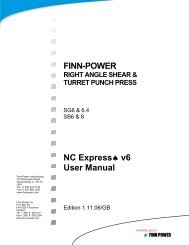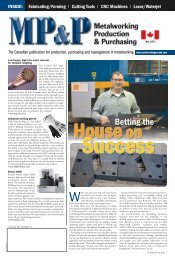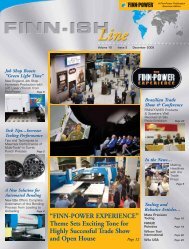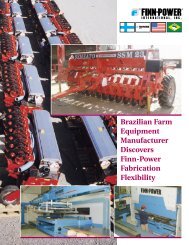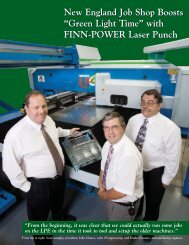Tooling Articles... Advanced Automation Enhances ... - Prima Power
Tooling Articles... Advanced Automation Enhances ... - Prima Power
Tooling Articles... Advanced Automation Enhances ... - Prima Power
You also want an ePaper? Increase the reach of your titles
YUMPU automatically turns print PDFs into web optimized ePapers that Google loves.
Continued from page 13<br />
5<br />
Maintenance and setup<br />
<strong>Tooling</strong> performance<br />
relates directly to<br />
the condition of the holders<br />
and their alignment in the<br />
turret. Look here first when<br />
noticing premature tool<br />
wear, chipping, sticky punches<br />
and saw-tooth cutting with<br />
auto-index stations. With<br />
improvements in computer<br />
hardware and software, along<br />
with closer integration of the<br />
programming systems, tool<br />
setup times are reduced, by<br />
having large, indexable, fulltonnage<br />
multi-tools to replace<br />
fixed tools at different angles<br />
in a turret, and by the ability to<br />
have a built-in electronic tool<br />
whiteboard on the control. This<br />
whiteboard automatically checks the NC program as it downloads<br />
into the machine, and changes it to match the tools in the control at<br />
the time. This also can reduce operation mistakes, as it alerts the setup<br />
operator should the tooling loaded in the turret not match that of<br />
the NC program. An easy-to-read screen on the control shows the<br />
turret layout, along with the tools being used (in green) for the current<br />
program (Fig. 3).<br />
6<br />
A tooling-wellness program<br />
Last, but by no means least, is investing in a well-planned<br />
and executed tooling-maintenance program. Lack of routine<br />
tooling maintenance is a primary cause of poor press productivity and<br />
excessive downtime, along with diminished part quality.<br />
PRIMA INDUSTRIE S.p.A<br />
Via Antonelli, 32<br />
10097 Collegno (To)<br />
ITALY<br />
Tel. +39 011 4103 1<br />
Fax. +39 011 411 28 27<br />
www.primaindustrie.com<br />
Fig. 3—An electronic tool whiteboard in the<br />
machine control alerts the setup operator<br />
should the tooling loaded in the turret not<br />
match that of the NC program. An easy-toread<br />
screen on the control shows the turret<br />
layout along with the tools being used for<br />
the current program (in green).<br />
FINN-POWER OY<br />
P.O. Box 38<br />
FIN-62201 Kauhava<br />
FINLAND<br />
Tel. + 358 6 428 2111<br />
Fax + 358 6 428 2244<br />
www.primapower.com<br />
PRIMA POWER<br />
NORTH AMERICA, INC.<br />
555 W. Algonquin Road<br />
Arlington Heights, IL 60005<br />
U.S.A.<br />
Tel. +1 847 952 6500<br />
Fax. +1 847 952 6530<br />
www.primapower.com<br />
Correctly sharpened and lubricated tooling makes for consistently<br />
clean holes and minimal edge burr, along with reduced slug pull. With<br />
the punch speeds turret presses now are capable of, tooling should be<br />
sharpened when the radius at the cutting point reaches no more than<br />
0.005 in. By sharpening tools at this point, fabricators can double the<br />
grind life of a tool and minimize machine downtime.<br />
Some basic guidelines:<br />
n Keep tools clean, and watch for wear – when punches dull too<br />
quickly, clearance may be too tight.<br />
n Remove galling by rubbing with a fine stone, parallel to the<br />
direction of the punching motion.<br />
n Watch for these possible signs of dull tools – excessive rollover, a<br />
noisy punch press and a press that begins to work too hard.<br />
n Sharpen frequently, in small amounts – remove 0.001 to 0.002 in./<br />
pass and repeat until the tool is sufficiently sharp, typically 0.005 to<br />
0.012 in. total.<br />
n Apply coolant with as much force and as close to the tool and<br />
grinding wheel as is practical.<br />
n Ensure use of the proper grinding wheel, and dress the wheel often<br />
by using a rigid single- or multi-point diamond.<br />
n After sharpening the punch tooling, lightly stone the cutting edges<br />
to remove any grinding burrs, leaving a 0.001- to 0.002-in. radius.<br />
n Provide the proper, recommended face geometry.<br />
n Observe proper setup practices.<br />
n Check press level and alignment and adjust as necessary.<br />
n Examine (and repair as necessary) punch and die holders for wear,<br />
and turret bores and die-holder seats for damage. Fix damaged<br />
keyways.<br />
n Extend tool life by ensuring proper tool and sheet lubrication.<br />
Happy Holidays<br />
This article appeared in the November 2011<br />
issue of MetalForming Magazine




